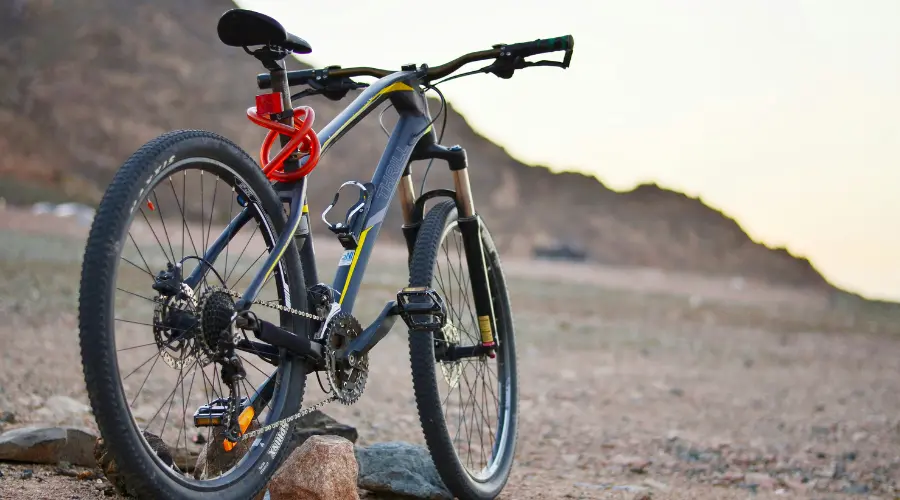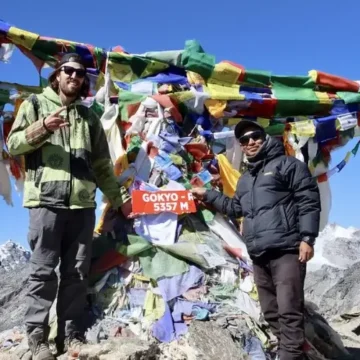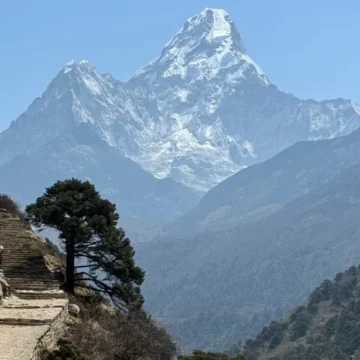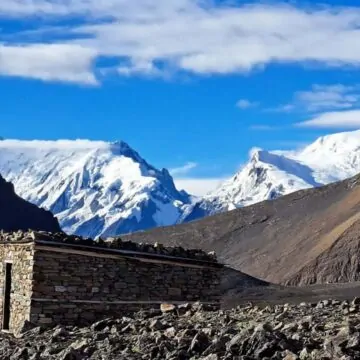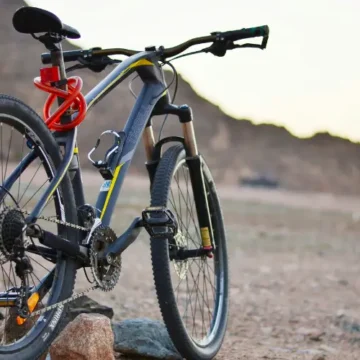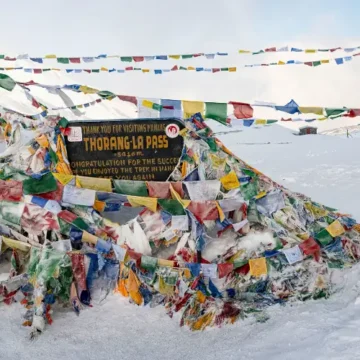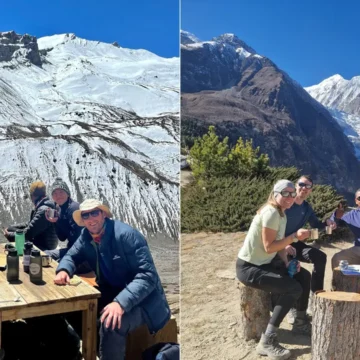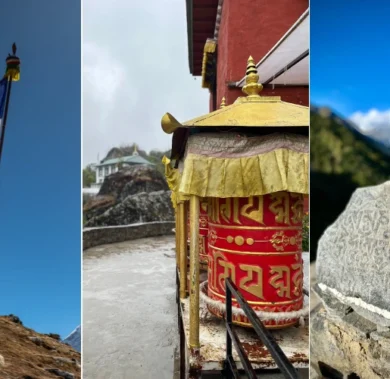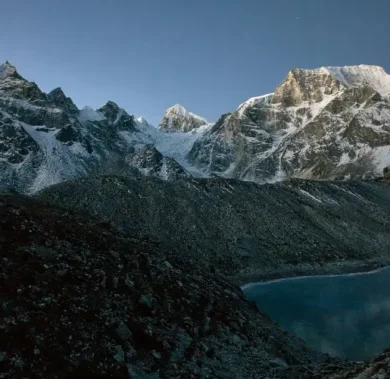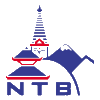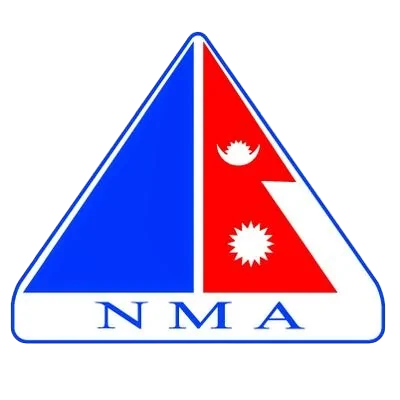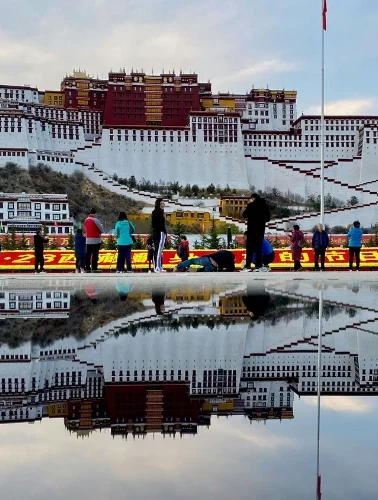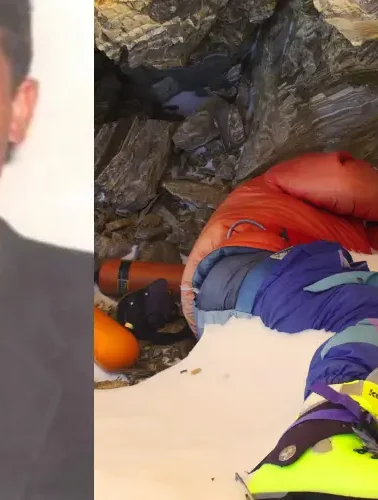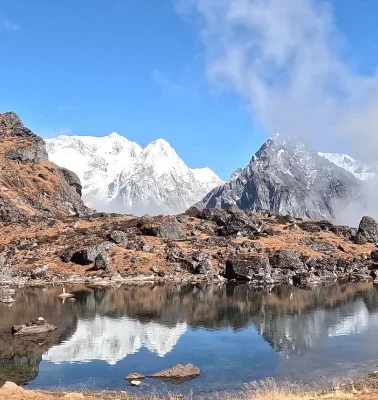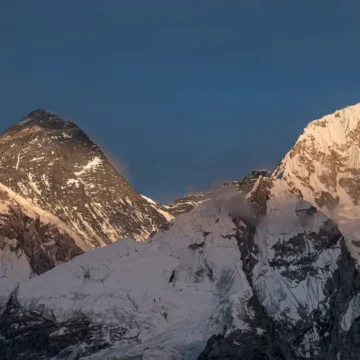
Annapurna Circuit Cycling – Route, Highlights and Best Time
Table of Contents
Has an extreme, wild thought of Annapurna Circuit Cycling ever crossed your mind? Annapurna Circuit Trek or a helicopter ride is quite alluring and exciting. However, though the trek route and cycling route are the same, the perspective, challenges, and thrill are on another level.
The Annapurna Circuit Cycling route isn’t just for the pro riders or an adrenaline junkie. It’s for anyone who dares to dream big and seek Himalayan adventure.
Annapurna Circuit is filled with soaring mountain passes, deep gorges, desert-like landscapes, Buddhist monasteries, and traditional, remote mountain villages. And you can witness all these on your bike.
Whether you choose Annapurna Circuit Mountain biking or bikepacking, this ride is as rewarding as it pushes you to your limit. No bus or trek can offer the thrill of Annapurna Circuit Mountain Biking.

Annapurna Circuit Cycling Route
The Annapurna Circuit cycling route begins in Besisahar (760 m) and ascends all the way to Thorong La Pass (5416 m) before descending into the Mustang region and concluding near Tatopani or Beni.
This anti-clockwise route, taking its visitors around the Mount Annapurna range, allows for gradual acclimatization and safety.
The trail starts on jeep trails, often parallel to trekkers on foot, through rice paddies and small Gurung Villages. As you climb higher, the environment changes to dense pine and rhododendron forests along the Marsyangdi River.
In recent years, motorable roads have reached most parts of the trail, making it easier for bikers. However, at some steep sections, you might have to push or carry your bike. These motorable roads have made the Annapurna Circuit Trek route accessible, a game changer for an Annapurna Circuit Mountain Biking adventure.
The route up to Manang is relatively easier and rideable. Beyond Manang, the route gets tougher. The landscapes transform into an arid, Tibetan-like plateau. You’ll find plenty of technical singletrack sections to challenge your skills, offering the best of both worlds.
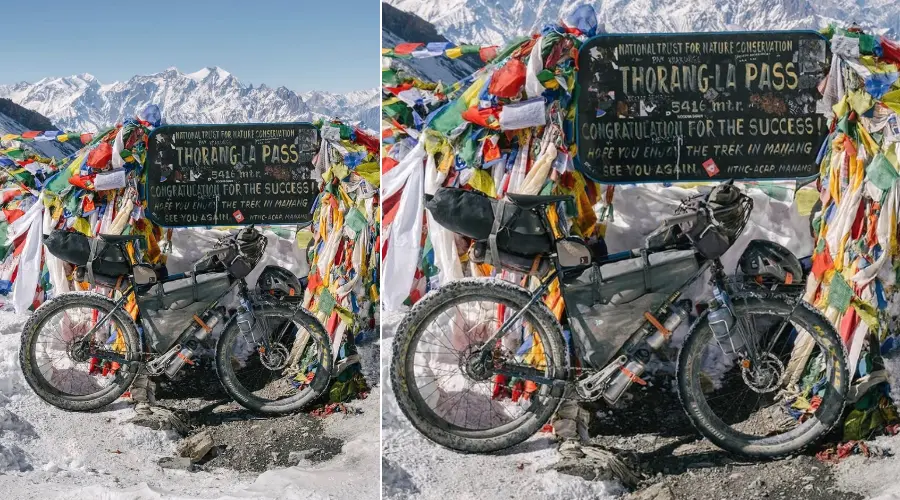
Annapurna Circuit How Many Days on Cycle
It’s not a race. Though cycling is faster than trekking, do not rush. Take time, enjoy the view, and let your body get enough rest.
It normally takes around 10-18 days for the Annapurna Circuit cycling, depending on your pace, acclimatization days, and side trips.
For experienced riders, the Annapurna circuit 7 days plan is also possible. But it is only possible with vehicle support and skipping acclimatization days. Also, it’s going to be really challenging, and we do not recommend this for most riders. Maybe you would like to extend your Annapurna circuit cycling trip by a few days towards Tilicho Lake.
Acclimatization in places like Manang is a must. If you’re not accustomed to high-altitude biking in Nepal or any part of the world, or avoid AMS at the high Annapurna circuit elevation of Thorong La, don’t skip acclimation day.
Best Time for Cycling the Annapurna Circuit
Be it the classical Annapurna Circuit Trek, cycling, or any trek in Nepal, choosing a favourable time for your trip is crucial for a safe, successful, and enjoyable journey.
Though the Annapurna Cycling route is open throughout the year, spring (March-May) and autumn (September-November) are ideal seasons for cycling.
These seasons offer the best weather and temperature for cycling, neither too cold nor too hot, but just perfect. The spring and autumn are characterized by clear blue skies, stable weather, blooming rhododendrons, and stunning panoramic views.
On the other hand, monsoon (June-August) and winter (December-February) mountain cycling is still possible, but we do not recommend cycling the Annapurna Circuit in these seasons.
Monsoon cycling becomes challenging due to frequent rain and slippery trails, and winter due to snowfall and extreme cold, often blocking high passes.
Bike and Gear Requirements
Cycling the Annapurna Circuit isn’t just about physical strength; it’s about being prepared. Smart packing is the key to a safe and comfortable Annapurna Circuit mountain bike experience.
Here’s what you need for this thrill.
Comfortable, Light, and Sturdy Bike
Make sure your bike has a good suspension. Good suspension is very important while riding rocky descents, jeep tracks, and even icy trails. Likewise, your bike should have good-quality hydraulic disc brakes.
You don’t want your bike to be heavy, as you will need to carry it in some steep sections.
A hardtail (front suspension only) mountain bike is also fine, but only for seasoned riders.
Note: As there is no bike repair centre en route, make sure you have good mechanical knowledge of repairing the bike you are using.

Other Essential Cycling Gear
The lighter, the better. But don’t compromise on essential gear. Try as minimal Annapurna bikepacking as possible, suitable for balance speed and comfort. We suggest layer packing according to the season you are packing.
Here’s a pro tip on what to pack for the Annapurna Circuit cycling.
Clothing
- Padded cycling shorts (2-3 pairs)
- Moisture-wicking cycling t-shirt (short and long-sleeved)
- A lightweight, packable, windproof and waterproof jacket and pants
- Thermal base layers (merino wool is excellent)
- A warm mid-layer fleece or insulated jacket
- Comfortable trousers and a T-shirt for evenings in the teahouse
- Warm hat (beanie), buff or neck gaiter, and sun hat
- Warm, waterproof gloves for high altitudes and lighter full-finger gloves for lower sections
Essential Extras
- Helmet: Absolutely non-negotiable.
- Cycling Shoes: Sturdy shoes with good grip for “hike-a-bike” sections.
- Water Bottle/Hydration Pack: A 2-3 litre pack is essential for staying hydrated at altitude.
- Sunglasses: High-quality, UV-protection sunglasses are a must.
- Sunscreen: The sun is incredibly strong at high altitudes.
- Basic First-Aid Kit: Include antiseptic wipes, bandages, blister treatment, and any personal medications. Also, include medication for altitude sickness (consult your doctor).
- Bike Repair Kit: Spare tubes, tyre levers, a pump, a multi-tool, chain lube, and zip ties.
- High-Energy Snacks: Energy bars, gels, and nuts are great for on-the-go fuel.
Permits and Guide
As you will be cycling within the Annapurna Conservation Area, you are required to obtain an Annapurna Conservation Area Permit (ACAP). It cost NPR 3000 (about $22). The amount collected from this permit goes towards conservation and infrastructure development.
You can either obtain this permit yourself from the Nepal Tourism Board Office in Kathmandu or Pokhara, or ask your trekking agency to arrange it.
If you’re travelling with Himalayan Masters, you don’t have to worry about any permits. We will arrange them for you, included in the trip package. Also, we provide an experienced cycling guide for the trip.
Hiring a local guide is highly recommended and a wise choice, too. They can provide you with hands-on knowledge of the route, local villages, and culture. Additionally, they will assist you with navigation, accommodation bookings, communicating with locals, addressing mechanical failures, and emergency evacuation procedures.
Likewise, hiring a porter will further boost your cycling experience. The porter will carry all your main pack, allowing you to enjoy the Annapurna Circuit bike ride with just a daypack.
Bike Rentals Facilities
In case you don’t have your own mountain bike or find it difficult to carry cargo and all, you can always rent or buy one in Nepal. Shops around Thamel, Kathmandu, and Pokhara sell and rent high-quality mountain bikes.
However, rates for bike rental facilities can range anywhere between $15 and $30 per day, depending on the model.
Look for shops that offer service and spare parts with a rental, and test properly for suspension, brake, gears and tyres before departure.
Annapurna Circuit Cycling Cost
On average, an Annapurna circuit cycling can cost between $800 and $2000, depending on the duration and how luxurious the services you want are. The cost includes all your transportation, accommodation, food, drinks, a guide, and other miscellaneous expenses.
Here’s an Annapurna Circuit Cycling Cost breakdown.
- Bike Rental: $200-$350 for about 2 weeks
- Permit: Nearly $25
- Guide/Porter: $25-$30 per day for a guide and $20-$25 for a porter
- Transportation: Privet bus: $10-$20 by (one way), Private jeep: $100-$150 for Kathmandu to Besisahar, $300 for Kathmandu to Dharapani (trailhead), $100 for Muktinath to Beni, $100 from Tatopani or Beni to Pokhara, $200 from Pokhara to Kathmandu, Flight: Kathmandu to Pokhara/Pokhara to Kathmandu costs $35-$50.
- Food: $15-$25 per day
- Miscellaneous: $10-$20 per day for charging, Wi-Fi, hot water, snacks, etc.
Is Annapurna Circuit Cycling Safe for Beginners?
In fact, if you’re considerably fit, properly acclimatize, and fully prepared, Annapurna Circuit Cycling is not only safe but spectacular for both beginners and seasoned cyclists.
Having said that, the route is not as easy. High altitude, rugged terrains, technical terrain, remoteness, and unpredictable weather make it really challenging for beginners. Due to remoteness, emergency rescues are challenging. And the lack of advanced medical facilities necessitates helicopter evacuation to nearby cities like Pokhara or Kathmandu.
The new road construction has especially made the region a true bikepacking classic. It’s a challenging, rewarding, and completely of-the-top experience.
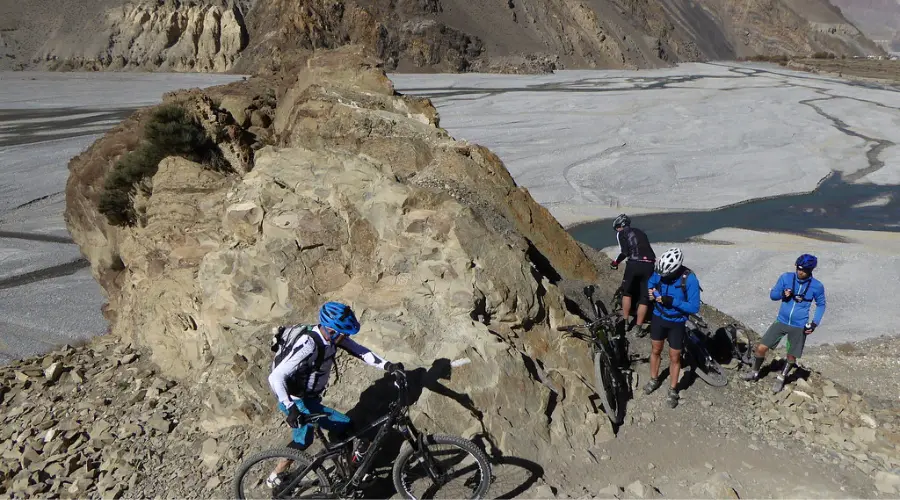
Annapurna Circuit Cycling Highlights
- Thorong La Pass: One of the most challenging ascents, yet the most thrilling descent from an elevation of 5416 meters (17,769 ft).
- A scenic ride through Manang Valley
- Muktinath Temple: Sacred pilgrimage site for both Hindus and Buddhists.
- Kali Gandaki Gorge: Descending into the world’s deepest gorge, with Annapurna I and Dhaulagiri towering on either side.
- Jaw-dropping panoramic views of peaks like Annapurna, Tilicho Peak, and Dhaulagiri.
- A rich Tibetan Buddhist village and rich Tibetan cultural immersion.
- Interaction with the local Gurung, Manangi, and Thakali people.
Where to Stay and What to Eat?
Annapurna Circuit trail is well established compared to other new trails in the Annapurna region. There are quite a lot of teahouses in the Annapurna Circuit route. These family-run teahouses provide comfortable, cozy accommodation with hearty, delicious and nutritious meals.
The rooms are basic, typically featuring two single beds, a blanket, a pillow, and a shared bathroom. However, as you go higher, they might be as nice as in the lower legion villages.
Moreover, you can find all sorts of veg, vegan and non-veg food menus. We suggest you eat Dal Bhat (a staple diet including rice, lentil soup, and vegetable curry). Other food options are Mo: Mo, noodles, pasta, apple pie, potato items, egg, pizza with yak cheese, etc.
Note: Avoid eating meat in higher villages, as they might not have a proper refrigeration system.
Annapurna Circuit Cycling Itinerary
Let’s see how many days it takes to complete the Annapurna Circuit cycling Itinerary.
| Route | Distance | Time |
| Drive from Kathmandu to Dharapani | 250 Km/155 miles | 8-9 hr |
| Cycling from Dharapani to Chame | 15.5 Km/9.6 miles | 3 hr |
| Cycling from Chame to Manang | 31 Km/19 miles | 6-7 hr |
| Acclimatization Day in Manang | — | Rest |
| Cycling from Manang to Yak Kharka | 10 Km/6.2 miles | 2-3 hr |
| Cycling from Yak Kharka to Thorong Phedi | 6 Km/3.7 miles | 2-3 hr |
| Cycling from Thorong Phedi to Muktinath via Thorong La | 15 Km/9.3 miles | 7-8 hr |
| Cycling from Muktinath to Tatopani/Beni | 70 Km/43.4 miles | 7-9 hr |
| Drive from Tatopani/Beni to Pokhara | 103 Km/64 miles | 4-5 hr |
| Drive from Pokhara to Kathmandu | 201 km/125 miles | 6-7 hr |
Annapurna Circuit Mountain Biking – Is It Possible?
Absolutely. Annapurna Circuit Mountain Biking is an emerging adventure option in the Annapurna region. With new road constructions, well-marked routes, cozy accommodations, food, and helpful, friendly neighbours, trekking as well as cycling the Annapurna Circuit is possible.
You can just hire a guide and start the trip, or you can choose any travel agency and let them handle all the logistics and traverse through the pristine, stunning Annapurna region.
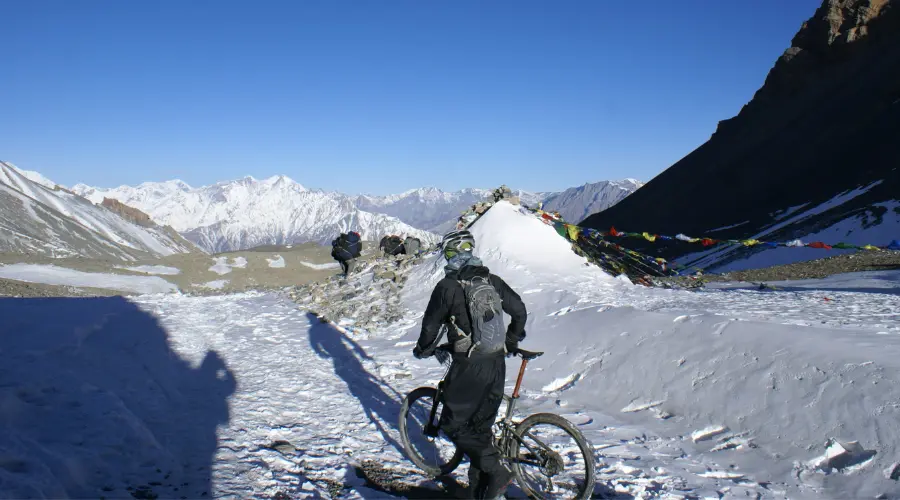
Is Annapurna Circuit still worth it?
From high mountain passes to mystical monasteries, the Annapurna Circuit cycling is far more exciting than just trekking. Despite road development, the route is dotted with Himalayan adventure, cultural immersion, wilderness, and some of the undisturbed landscapes.
Annapurna circuit bikepacking is the perfect blend of challenge and comfort. So yes, Annapurna circuit cycling is not only worth it but might be the best way to explore the Himalayas.
Annapurna Circuit Cycling With Himalayan Masters
Cycling the Annapurna Circuit with Himalayan Masters is the perfect way to combine adventure with expert support.
We, Himalayan Masters, are the best trekking company in Nepal, with 5-star ratings on TripAdvisor and Google Reviews. Himalayan Masters is known for its well-organized tours in the Himalayas. We ensure a smooth ride across the challenging terrains.
Himalayan Masters are here to provide assistance 24/7, even before and after the trip. Whether you’re new or a seasoned mountain biker, we assure you that you are well taken care of.
For any enquiry regarding trek or cycle rides in the Himalayas, do contact us at our email ([email protected]), WhatsApp (+977-9823636377), or visit our office at Thamel, Kathmandu.
Want to know more?
Speak to an Expert





Sandip Dhungana
Nepal 🇳🇵
Whatsapp: +977-9823636377

